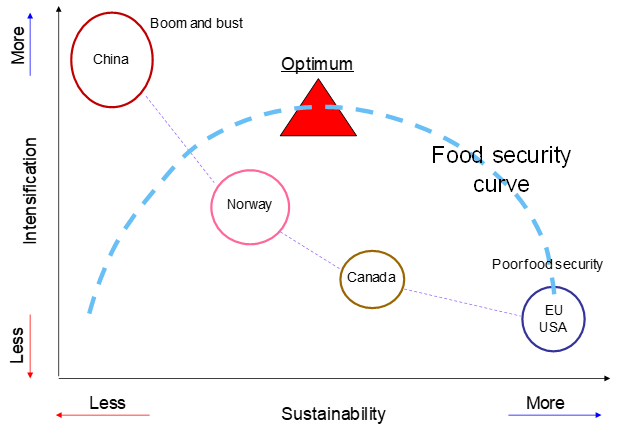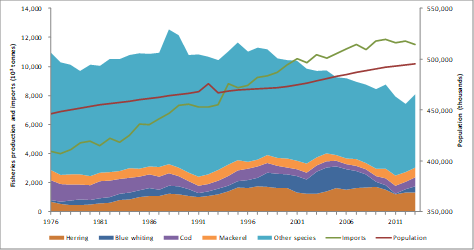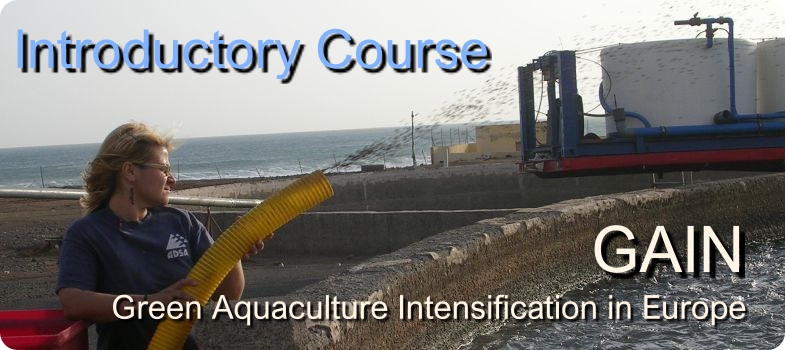How can ecological intensification be applied to aquaculture and why is it crucial for the future of the EU?
How the concept of ecological intensification can be applied in aquaculture
Presentation
Worldwide demand for aquatic products is rising due to both population
growth and increased fish consumption per capita (+13% from 2000 to 2012). This
demand is expected to increase by 57% between 2005 and 2050 (FAO 2010).
As fishery catches have probably reached their maxima, this growing demand for aquatic products can only be met by aquaculture: in fact, aquaculture production has steadily increased worldwide since the 1980s. However, uncontrolled intensification of production has sometimes led to environmental and social concerns and the increase of aquaculture production could lead to even more problems. The ecological intensification of aquaculture could address these concerns, combining production increase and impact reduction.

Figure 1: Trade-offs (not to scale) between intensification and sustainability
For the aquatic sector, ecological intensification may be expressed as increased production of good fish, being well defined as promoting nutritious and tasty products, animal welfare, and ecosystem balance. Eco-intensification is a direction, rather than an end-point, as exemplified schematically in Fig. 1, and the challenge for Europe is to place production in the optimum region shown, a trade-off between intensification and sustainability. The food security curve tracks this path and illustrates that at the other end of the spectrum, the intensive production seen in China and South-East Asia can also lead to poor food security, due to sustainability issues, and highly variable harvests which are conditioned by occasional severe water quality impairment and disease events, aggravated by unsustainable stocking densities and a poor understanding of system-scale responses.
Typical examples of ecological intensification in aquaculture are:
- The re-use of aquaculture by-products in a circular economy approach
- Integrated farming of fishes (e.g. carps) in ponds that are fertilised with manure from associated livestock rearing (such as pigs).
In Europe, the public perception of aquaculture is considered to be rather negative, at least in segments of the popular press (Froelich et al 2017), but farmed fish now exceeds wild capture for human use (FAO, 2016), and the diet of European consumers has reflected this for at least a decade (Cressey, 2009). Fig. 2 shows how fisheries, imports (green line), and population (red line) in the EU and Norway have changed in the last forty years. A marked decline in capture fisheries, steady increase in the European population, and increasing dependence on imported aquatic products mean that European aquatic food security in the next years depends on sustainable (eco), and substantial (intensified) growth of the aquaculture sector.

Figure 2: Evolution of capture fisheries, imports, and population (EU + Norway) in the last forty years
In order to address these challenges, the introduction of ecological intensification proposes a paradigm shift, trying to promote new practices able to secure the future of European aquaculture, preserve the ecosystems, and ensure fish welfare. The ecological intensification of European Union and European Economic Area aquaculture is a complex challenge, but no other alternative will satisfy the increasing demand for high-quality aquatic products and reduce dependence on imports, which, in the EU 28, reached 65% in 2008-2012 (STECF, Undated)
Successful eco-intensification of aquaculture in Europe will then provide more and better aquatic products, a better environment, more jobs, and improve trade balance by reducing imports.
To go further
Cressey, D.,
2009. Aquaculture: Future fish. Nature 458, 398-400. https://doi.org/10.1038/458398a
FAO, 2010.
Aquaculture development. 4. EFAO Technical Guidelines for Responsible Fisheries
5. Suppl. 4, Rome (53 pp.). https://www.fao.org/3/i1750e/i1750e00.htm
FAO, 2016. The
state of world fisheries and aquaculture (SOFIA). FAO, Rome, 204 pp. https://www.fao.org/3/i5555e/I5555E.pdf
Froehlich,
H.E., Gentry, R.R., Rust, M.B., Grimm, D. & Halpern, B.S. 2017. Public
perceptions of aquaculture: evaluating spatiotemporal patterns of sentiment
around the world. PLoS ONE, 12:1-18. https://doi.org/10.1371/journal.pone.0169281
Scientific
Technical and Economic Committee for Fisheries (STECF). Publications Office of
the European Union, Luxembourg. https://stecf.jrc.ec.europa.eu/reports
